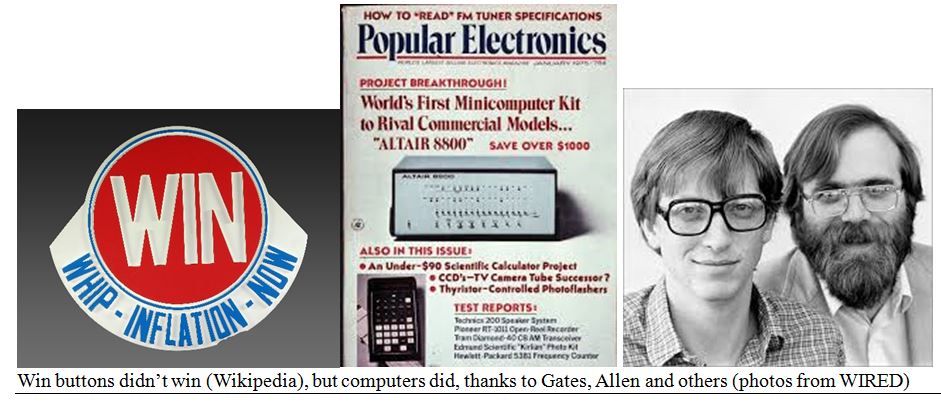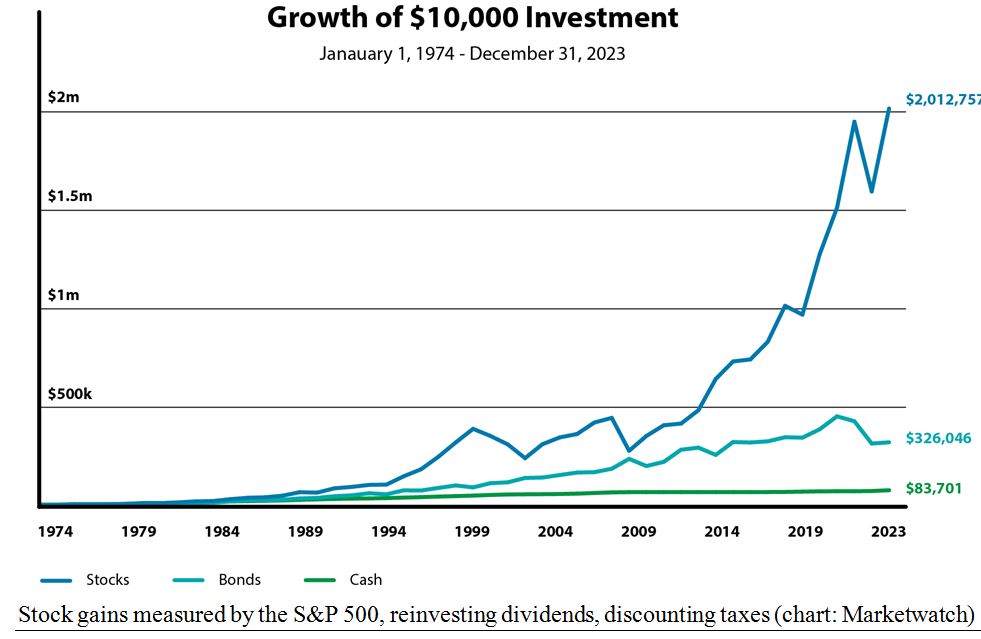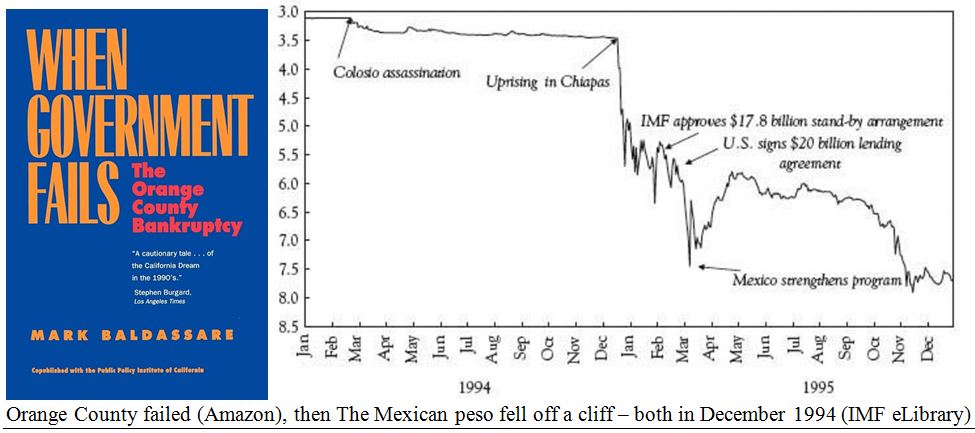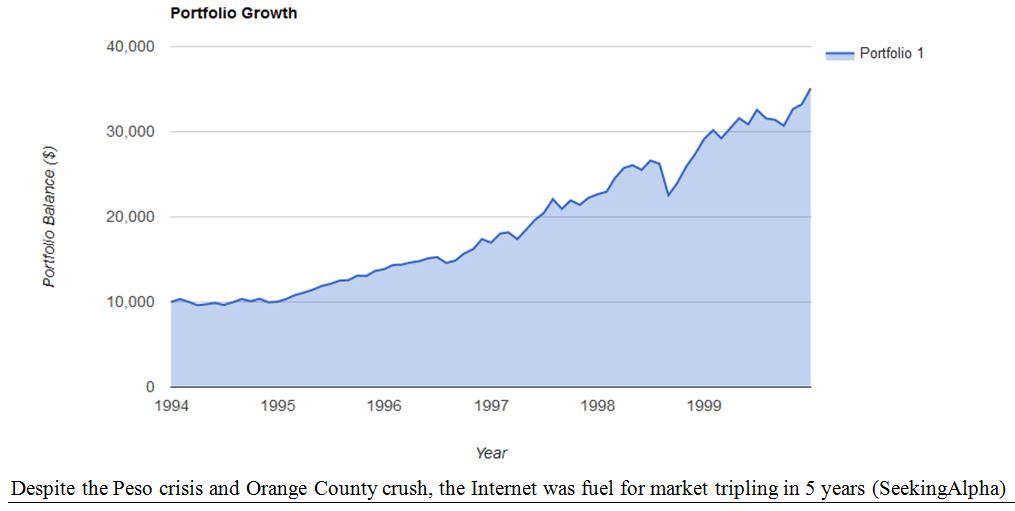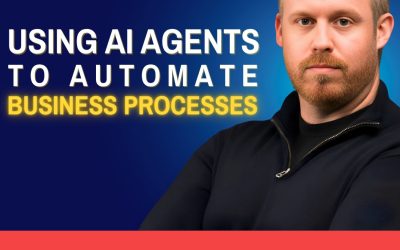by Gary Alexander
December 3, 2024
At the 50th Annual New Orleans Investment Conference (November 20-23), I couldn’t help remembering the events of 1974, when the conference was born. I wasn’t there, but I helped conference founder James U. Blanchard III write his memoirs, “Confessions of a Gold Bug,” in 1989 by multiple interviews and a deep dive into his archives. I was also a financial journalist for a major national magazine from 1967 to 1975, covering the dollar devaluation, rise of Japan, globalization and deficits that began back then.
In this week’s column, I’d like to take you back to three times of trouble in December 1974, 1994, and 2019 – 50, 30 and five years ago this week – to show how times of trouble often deliver the highest profits, or, as Baron Rothschild put it in 1815, “The time to buy is when there’s blood in the streets.”
100-Fold Market Gains in the Last 50 Years
50 years ago: The week of December 2-6, 1974, marked the stock market’s absolute bottom in the 1970s. On Monday evening, December 2, 1974, President Gerald Ford addressed the nation in a televised speech in which he sounded the alarm for three major economic crises happening at once – inflation, recession, and a major oil shortage. President Ford thought his WIN buttons (Whip Inflation Now) were the solution rather than reducing spending or monetary expansion. The following week, on Friday, December 13, the former Beatle George Harrison visited the White House and exchanged buttons: Ford gave Harrison a ‘WIN’ button, while Harrison gave Ford an equally useless (to Ford) ‘OM’ (meditation mantra) button,
As the market struggled to recover, it was politics as usual, as powerful Congressman Wilbur Mills (D-Ark.), chairman of the Ways and Means Committee, chose to retire in the wake of the first major public sex scandal in postwar America. He had been caught in the DC Tidal Basin at 2:00 am on October 7th with a stripper, Fanne Fox. Despite that, he was re-elected to Congress on November 5th, but calls for Mills to resign mounted, so he left office on December 13th. The stock market rose 14 points (+2.5%) that Tuesday, from Dow 579 to 594, the first strong daily gain after from the absolute low of 577.6 on the previous Friday. (The stock market also rose when President Clinton admitted his in-office affair).
As usual, the seeds of recovery had nothing to do with headlines about politics, inflation or sex scandals. The PC revolution was quietly launched on December 19, the same day Nelson Rockefeller was sworn in as Ford’s Vice President. On that day, the Altair 8800, a do-it-yourself computer kit, went on sale for $397. It used switches for input and flashing lights as a display. The Altair 8800 was featured on the cover of the January 1975 Popular Electronics, where it caught the attention of a Harvard student, Bill Gates.
Gates and his buddy Paul Allen wrote programs for large business computers during high school, and they realized that the Altair would need a programming language, so they quickly created a version of BASIC (Beginners’ All-Purpose Symbolic Instruction Code) to run on Altair. Gates and Allen soon dropped out of Harvard and went to Albuquerque to sell Ed Roberts, founder of Altair’s maker, Micro Instrumentation and Telemetry Systems (MITS), their operating system. Their demonstration of BASIC for Altair worked out well, even though the two kids had never seen an Altair before. Gates and Allen established Micro-Soft (later Microsoft), in Albuquerque. They later moved to Seattle, where they had gone to high school.
Partly due to the tech boom, stocks gained 20-fold over the next 25 years, and 77- to 330-fold in 50 years:
Graphs are for illustrative and discussion purposes only. Please read important disclosures at the end of this commentary.
Oh, by the way, on the final day of December 1974, gold was finally legal for Americans to own, after more than 41 years of prohibition, thanks to FDR. This legalization came about due to lobbying by the organizers of the New Orleans conference, the National Committee to Legalize Gold. Today, gold is up 130-fold from its price of $20.67, which Americans were paid in 1933, when it was confiscated, but Americans were not allowed to participate in the first big gains – to $190 per ounce by year-end 1974.
10-to-25-Fold Gains from the Crises (and Opportunity) of December 1994
Those who lived through the markets of December 1994 won’t remember the birth of the Internet. They will remember the headlines of the Tequila crisis – the peso crisis – and the bankruptcy of Orange County.
On December 6, 1994, Orange County (California) declared Chapter 9 bankruptcy in the single biggest bankruptcy filing by a municipality in American history. The county’s losses from derivative investments reached $2 billion before officials decided to surrender all hope. The Dow fell 60 points (-1.7%) in the next two days to 3,685. These losses were exacerbated by the Fed’s six interest rate increases since February of 1994 in Fed Chair Alan Greenspan’s war against phantom inflation, causing an economic slowdown (but not a recession), which may have fueled the Republican Revolution in November 1994.
Later in December, the Mexican central bank suddenly devalued the peso on December 20, 1994, and investors added an even higher risk premium to all peso-based investments. To discourage any further capital flight, the Bank of Mexico raised interest rates, but that cost them dearly, hurting economic growth and resulting in threats of a default, as few investors were interested in buying any new Mexican bonds.
Mexican inflation rose to 52% and mutual funds began liquidating Mexican assets and other emerging market assets throughout the rest of Latin America and Asia, forcing an IMF bailout in January 1995.
Graphs are for illustrative and discussion purposes only. Please read important disclosures at the end of this commentary.
Precisely in the middle of these two scary debt-driven events, on Tuesday, December 13, 1994, the first meeting of the World Wide Web Consortium took place at the Massachusetts Institute of Technology. This ad-hoc international association was formed to promote the common protocols of the World Wide Web.
The Web’s creator, Tim Berners-Lee, became the first director. Berners-Lee had helped to develop the Web while he was a fellow at CERN, the European particle physics lab, in Geneva, in the early 1990s.
On the day the Internet was born, the Dow index stood at 3,715. In the next two weeks, the Dow gained 146 points (+4%). More importantly, it tripled in the following five years, partly on the euphoria of this new Web creation, hatched in Geneva and nurtured in America, without government input or control.
Graphs are for illustrative and discussion purposes only. Please read important disclosures at the end of this commentary.
Finally, five years ago, a new bug emerged from Wuhan, China. It was called COVID-19 because it was born in 2019, not 2020. Symptoms of the index case (“patient zero”) began on December 1, 2019. This poor fellow had never been to the seafood market that was initially blamed for the disease, but there were 40 infected people in that first week of December, as reported by the Wuhan City Health Committee.
This lab bug resulted in the worst pandemic in a century, since the “Spanish flu” (no connection to Spain) of 1918-19, which killed 17 to 50 million in a world of 1.8 billion (i.e., 1% to 3% of the population at that time). COVID killed an estimated seven million out of more than seven billion people, or just 0.1% of us.
Since that first COVID-19 case, the S&P 500 is up 94%, the Dow is up 62% and NASDAQ is up 124%.
Today’s situation may not look so bad in the headlines, but the debt/demographic time bomb is ticking…. Either way, don’t let bad news fool you. When times are darkest, the profit opportunity is often brightest.
Navellier & Associates owns Microsoft (MSFT), in some managed accounts. Gary Alexander does not own Microsoft (MSFT) personally.
The post 12-3-24: Seeds of Great Fortunes are Often Sown in Times of Great Trouble appeared first on Navellier.




